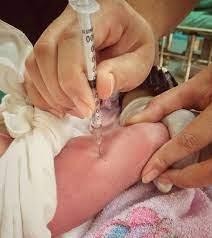A nurse is reinforcing teaching with a client about how to minimize nausea in the first trimester of pregnancy. Which of the following instructions should the nurse give to the client?
Have a high-fat snack before going to bed.
Limit snacks between meals.
Drink 240 mL (8 oz) of water with each meal.
Eat a slice of dry toast before getting out of bed.
The Correct Answer is D
A) Incorrect- Having a high-fat snack before bed might exacerbate nausea. It's generally recommended to have a light snack if needed.
B) Incorrect- Eating small, frequent snacks between meals can help manage nausea by preventing an empty stomach.
C) Incorrect- Drinking water with meals might not necessarily help with nausea and might worsen the feeling of fullness.
D) Correct - "Eat a slice of dry toast before getting out of bed" can help alleviate morning sickness in the first trimester. Eating a small, bland snack before rising can prevent an empty stomach, which can contribute to nausea.
Nursing Test Bank
Naxlex Comprehensive Predictor Exams
Related Questions
Correct Answer is C
Explanation
A) Incorrect- Administering medication into the deltoid muscle is not typically done in newborns. Phytonadione is given intramuscularly, usually in the vastus lateralis muscle, not the deltoid muscle.
B) Incorrect- Phytonadione should be given within 1 hour of birth, not 12 hours after birth. Delaying the administration increases the risk of bleeding complications.
C) Correct- The size of the needle is important for the newborn's comfort, A 25-gauge needle is the appropriate size for administering phytonadione to a newborn. A smaller needle may not deliver the medication adequately, and a larger needle may cause more tissue damage and bleeding.
D) Incorrect- The mother's Rh factor is irrelevant for the administration of phytonadione.
Rh factor affects the risk of hemolytic disease in the newborn, which is a different condition from hemorrhagic disease.

Correct Answer is B
Explanation
A) Incorrect- Elevating a baby's head with a cushion during sleep is not recommended, as it can increase the risk of sudden infant death syndrome (SIDS) and obstructed breathing.
B) Correct - "I should replace the batteries in my smoke detector twice per year." Regularly replacing smoke detector batteries helps ensure they function properly in case of a fire emergency.
C) Incorrect- Setting the hot water heater to 130°F (54.4°C) is too hot and can cause scalding burns. The recommended temperature is 120°F (48.9°C) or lower.
D) Incorrect- Baby powder is not recommended for use with diaper changes, as it can be inhaled by the baby and lead to respiratory issues.
Whether you are a student looking to ace your exams or a practicing nurse seeking to enhance your expertise , our nursing education contents will empower you with the confidence and competence to make a difference in the lives of patients and become a respected leader in the healthcare field.
Visit Naxlex, invest in your future and unlock endless possibilities with our unparalleled nursing education contents today
Report Wrong Answer on the Current Question
Do you disagree with the answer? If yes, what is your expected answer? Explain.
Kindly be descriptive with the issue you are facing.
